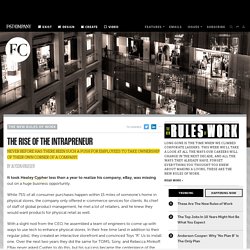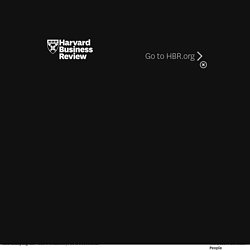

Authentic Workplaces Don’t Try to Make Everyone the Same. Look around your organization, at the people with whom you interact every day.

What do you see? Does your workplace reflect a relative balance of males and females in leadership positions? A healthy range of diversity in terms of age, skin color, religious conviction, culture, or/and sexual orientation? Yes? Before you congratulate yourself on how diverse your workplace is, what if we told you it might not be diverse enough — or at least not in the ways that matter most? Publications and Presentations. Why More and More Companies Are Ditching Performance Ratings. Stop Trying to Please Everyone. Many of us are familiar with the concept of Getting to Yes, an iconic negotiation strategy developed by Harvard professor Roger Fisher and others.

For many managers, however, the more difficult day-to-day challenge is “getting to no” which is what we call the process for agreeing on what not to do. “Getting to no” is a classic management issue because the vast majority of us tend to accept requests and assignments without first filtering them by what’s possible, what’s urgent, and what’s less of a priority. In an age when we are encouraged to be “team players” and responsive to colleagues, it may seem counter-intuitive or even selfish to encourage managers to say no more often, but that is exactly what many need to do. While saying yes to every assignment may initially please senior execs, it usually leaves people over-stressed and inundated with work — a lot of which ends up half-finished or forgotten.
In the long run, no one is happy. Are You Leading Like It’s 1980? Employment isn’t what it used to be and it’s not what it should be.

Reid Hoffman said it right, “You can’t have an agile company if you give employees lifetime contracts—and the best people don’t want one employer for life anyway. But you can build a better compact than ‘every man for himself.’” A new compact needs to be forged that’s win-win, one under which employees provide skills that build businesses and employers offer experiences that build careers.
A key element to making this shift is changing the focus of the annual performance review process from a backward-looking, narrow perspective that answers, “What have you done for me lately?” To a forward-looking, productive conversation that asks, “How can you contribute to the company, and how does this benefit your career?” There’s broad agreement that the traditional performance-management approach, (courtesy of GE in the 1980s) has outlived its usefulness.
Kill Your Performance Ratings. Evidence is mounting that conventional approaches to strategic human capital management are broken.

This is particularly true for performance management (PM) systems—the appraisal approaches in which employees (working with their managers) set goals for the year; managers interview others who have worked with them and write up an appraisal; employees are rated and ranked numerically; and salary, bonus, and promotion opportunities are awarded accordingly. A 2013 survey by the Society for Human Resource Management asked HR professionals about the quality of their own PM systems; only 23 percent said their company was above average in the way it conducted them. Other studies uncovered even more disdain. According to the Corporate Executive Board (CEB), a management research group, surveys have found that 95 percent of managers are dissatisfied with their PM systems, and 90 percent of HR heads believe they do not yield accurate information.
How Your Brain Responds to Performance Rankings. The Rise Of The Intrapreneur. It took Healey Cypher less than a year to realize his company, eBay, was missing out on a huge business opportunity.

While 75% of all consumer purchases happen within 15 miles of someone's home in physical stores, the company only offered e-commerce services for clients. As chief of staff of global product management, he met a lot of retailers, and he knew they would want products for physical retail as well. With a slight nod from the CEO, he assembled a team of engineers to come up with ways to use tech to enhance physical stores. In their free time (and in addition to their regular jobs), they created an interactive storefront and convinced Toys "R" Us to install one.
Over the next two years they did the same for TOMS, Sony, and Rebecca Minkoff. Data Can Make for Cutthroat Coworkers. The introduction of data to the workplace has been hailed as a revolution as often as it has been assailed as a digital Big Brother.

Just last month, The Wall Street Journal deemed data "the new middle manager"—a way for start-ups to transparently take cost-cutting measures that are backed up by numbers. At the same time, another trend has been taking hold in the management realm: an increasing emphasis on employee happiness and teamwork.
Keeping employees content and engaged is widely considered important for both productivity and profits. Why Compassion Is a Better Managerial Tactic than Toughness. Stanford University neurosurgeon Dr.

James Doty tells the story of performing surgery on a little boy’s brain tumor. In the middle of the procedure, the resident who is assisting him gets distracted and accidentally pierces a vein. With blood shedding everywhere, Doty is no longer able to see the delicate brain area he is working on. The boy’s life is at stake. Doty is left with no other choice than to blindly reaching into the affected area in the hopes of locating and clamping the vein.